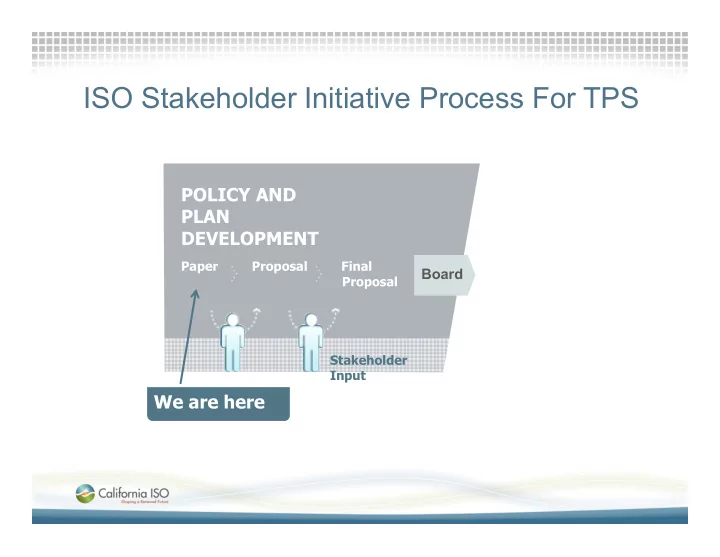

ISO Stakeholder Initiative Process For TPS POLICY AND PLAN DEVELOPMENT Paper Proposal Final Board Proposal Stakeholder Input We are here
Agenda – May 2, 2011 ISO Planning Standards Stakeholder Meeting 1. Introductions and Meeting Arrangements 2. Standards A. SF/GBA generation outage - retired B. Combined line and generator outage – no change C. Specific nuclear units – no change D. Combined cycle module as G-1 – added E. Voltage - added F. New transmission vs. involuntary load interruption – revised 3. Guidelines A. New Special Protection Systems – revised 4. Glossary 5. Next Steps and Schedule
ISO Planning Standards Catalin Micsa Lead Regional Transmission Engineer Stakeholder Meeting May 2, 2011
Introduction Status of updates to the ISO Planning Standards: Current approved standards have been in place since 2002 http://www.caiso.com/docs/09003a6080/14/37/09003a608014374a.pdf 2008 stakeholder process was discontinued in 2008 http://www.caiso.com/1c58/1c58e461106b0.html Current stakeholder process initiated to revise planning standards http://www.caiso.com/2b61/2b6197d15eb0.html Slide 4
Existing Standards and Criteria During its planning activities ISO must : Follow all NERC Reliability Standards like http://www.nerc.com/page.php?cid=2|20 Transmission Planning (TPL) Nuclear Plant Interface Requirements (NUC-001) Follow all WECC Regional Criteria http://www.wecc.biz/Standards/WECC%20Criteria/Forms/AllItems.aspx Follow ISO Planning Standards Slide 5
New Structure and Documentation for the ISO Planning Standards Standards: Combined Line and Generator Outage Standard Voltage Specific Nuclear Unit Loss of Combined Cycle Power Plant Module as a Single Generator Outage Planning for New Transmission versus Involuntary Load Interruption Guidelines: New Special Protection Systems Slide 6
Retirement of San Francisco Greater Bay Area Generation Outage Standard: Eliminated requirements related to Hunters Point and Potrero San Francisco reliability is independent of generation requirement New transmission infrastructure has reduced the Greater Bay Area’s overall dependence on generation Additional planned transmission infrastructure will further diminish the Greater Bay Area’s overall dependence on generation Slide 7
Some standards were not changed Combined Line and Generator Outage Standard: One generator out of service followed by system readjustment and a single line outage should meet NERC TPL002 reliability standard for single contingencies Specific Nuclear Unit Standards: Respect Appendix E of the Transmission Control Agreement regarding nuclear power plants http://www.caiso.com/docs/09003a6080/25/a3/09003a608025a3bd.pdf Slide 8
Old enforcement is now a standard Loss of Combined Cycle Power Plant Module as a Single Generator Outage Standard: ISO has consistently enforced this standard Measure is based on historical data and “greater than 1 event over a 3 year period” Exceptions are possible After 2 years of operation Supported by historical data Addressed on a case by case base only Slide 9
New standard is proposed Voltage Standard: Common denominator is envisioned across ISO Low voltage and voltage deviation apply to load (including generator auxiliary load) buses High voltage apply to all buses Exceptions allowed if vetted through open process Contingency Conditions (TPL-002 & Normal Conditions (TPL-001) Voltage Deviation TPL-003) Voltage level Vmin (pu) Vmax (pu) Vmin (pu) Vmax (pu) TPL-002 TPL-003 <= 200 kV 0.95 1.1 0.90 1.1 ≤5% ≤10% >= 200 kV 0.95 1.1 0.90 1.1 ≤5% ≤10% >= 500 kV 1.0 1.1 N/A 1.1 N/A N/A Slide 10
Revised standard Planning for New Transmission versus Involuntary Load Interruption Standard: Continues to rely on NERC standards and WECC regional criteria New write-up and changes will address: Caps amount of involuntary load interruption based on WECC self imposed reporting requirements Establishes a maximum level for radial substations Establishes minimum sizing of back-tie(s) for radial loads Allows justification of transmission reinforcements through BCR calculation on a case by case basis Slide 11
Planning for New Transmission versus Involuntary Load Interruption Standard 1. No single contingency with load drop above 250 MW Cap NERC TPL002 footnote for single contingencies Avoids WECC reporting requirements for single contingencies 2. All substations of 100 MW or more need to be looped Standardize PTOs substations design Does not preclude substations with less then 100 MW from being looped in Slide 12
Planning for New Transmission versus Involuntary Load Interruption Standard 3. Minimum size for back-tie(s) Most stringent between 50% of peak load or 80% of the hours in the year (based on actual load shape for the area) Maintains a minimum level of back-tie(s) in order to assure a minimum level of service consistent across the system 4. Benefit to Cost Ratio > 1 may justify upgrades Allow elimination or reduction in load drop exposure if it has overall economic benefits BCR calculation to be supplied with the project through the open window and discussed in an open stakeholder process Slide 13
This guideline was slightly modified New Special Protection Systems Guideline: Small revisions to the existing guidelines Applies to new SPS for both load and generation Eliminated restriction on SPS for RMR units No changes to maximum arming amounts Increased the number of contingencies (single or double) that would trigger the operation of SPS from 4 to 6 local contingencies Slide 14
Glossary Here are a few examples: Bulk Electric System – all facilities under ISO control Development of load models – PTOs, UDCs and others Development of load forecast – CEC Projected customer demand 1 in 5 load level for regional studies 1 in 10 load level for local area studies Timed allowed for manual readjustment – less than 30 minutes Slide 15
Next Steps - Schedule Overall timeline – Post draft ISO Planning Standards April 25, 2011 – Stakeholder Meeting to discus changes May 2, 2011 – Submit comments by May 9, 2011 – Posting of second draft ISO Planning Standards May 13, 2011 – ISO Stakeholder conference call May 20, 2011 – Submit comments by May 27, 2011 – Finalize ISO Planning Standards June 2, 2011 – ISO Board of Governors June 29-30, 2011 – Implementation July 1, 2011 Your comments and questions are welcome. Your comments and questions are welcome. For written comments, please send to: RegionalTransmission@caiso.com Slide 16
Recommend
More recommend